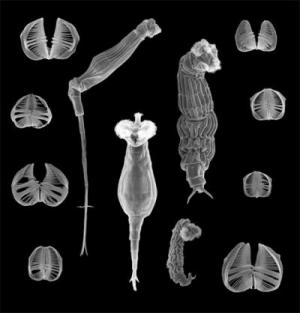Roughly a half-millimeter in size and commonly observed under microscopes in high-school biology classes, bdelloid rotifers are highly unusual in several regards: They appear to be exclusively asexual, have relatively few transposable genes, and can survive and reproduce after complete desiccation at any stage of their life cycle.
Scientists at Harvard University hypothesize that this last property explains something new about bdelloids - their apparently unique resistance to radiation.

A new study shows bdelloid rotifers are extraordinarily resistant to ionizing radiation, surviving and continuing to reproduce after doses of gamma radiation much greater than that tolerated by any other animal species studied to date.
Because free radicals such as those generated by radiation have been implicated in inflammation, cancer, and aging in higher organisms, the findings could stimulate new lines of research into these medically important problems.
"Bdelloid rotifers are far more resistant to ionizing radiation than any of the hundreds of other animal species for which radiation resistance has been examined," says Meselson, Thomas Dudley Cabot Professor of the Natural Sciences in Harvard's Faculty of Arts and Sciences. "They are able to recover and resume normal reproduction after receiving a dose of radiation that shatters their genomes, causing hundreds of DNA double-strand breaks which they are nevertheless able to repair."
Meselson and Gladyshev found that the bdelloid rotifers Adineta vaga and Philodina roseola remained reproductively viable after doses of radiation roughly five times greater than other classes of rotifers and other animals could endure.
Such radiation resistance appears not to be the result of any special protection of DNA itself against breakage, the researchers say, but instead reflects bdelloid rotifers' extraordinary ability to protect their DNA-repairing machinery from radiation damage.
Bdelloid rotifers have been widely studied since at least 1702, when the renowned Dutch scientist and microscopy pioneer van Leeuwenhoek added water to dust retrieved from a rain gutter on his house and observed the organisms in the resulting fluid. He subsequently described the creatures in a letter to Britain's Royal Society, which still counts an envelope of van Leeuwenhoek's rain-gutter dust among its holdings.
Meselson and Gladyshev's work is supported by the National Science Foundation's Eukaryotic Genetics Program.
Article: Eugene Gladyshev and Matthew Meselson, 'Extreme resistance of bdelloid rotifers to ionizing radiation', Proc. Natl. Acad. Sci. USA, 10.1073/pnas.0800966105


